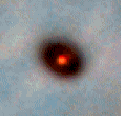Protostar
A nebula is a cloud of dust and gas, composed primarily of hydrogen (97%) and helium (3%). Within a nebula, there are varying regions when gravity causes this dust and gas
to “clump” together. As these “clumps” gather more atoms (mass),
their gravitational attraction to other atoms increases, pulling
more atoms into the “clump.”
What causes these “gravitational
centers” to form in these huge clouds? Adding atoms to the center of a protostar is a process astronomers
call accretion. Because numerous
reactions occur within the mass of forming star material, a protostar
is not very stable. |
||||||
|
||||||
| 1. Gravity pulls gas and dust inward toward the core. | ||||||
| 2. Inside the core, temperature increases as gas atom collisions increase. | ||||||
| 3. Density of the core increases as more atoms try to share the same space. | ||||||
| 4. Gas pressure increases as atomic collisions and density (atoms/space) increase. | ||||||
| 5. The protostar’s gas pressure RESISTS the collapse of the nebula. | ||||||
| 6. When gas pressure = gravity, the protostar has reached equilibrium and accretion stops | ||||||
|
||||||




